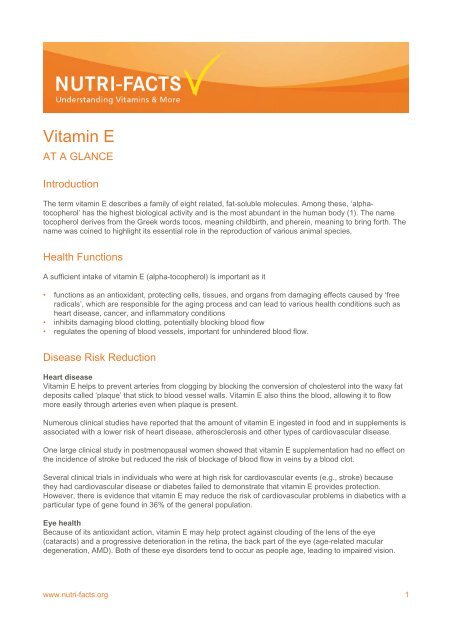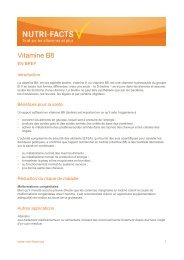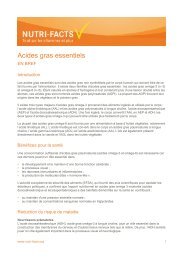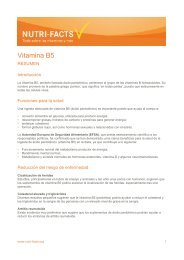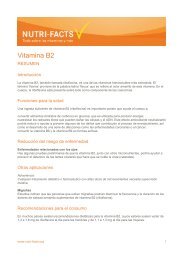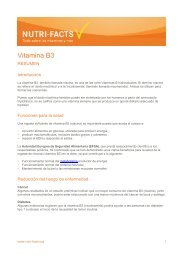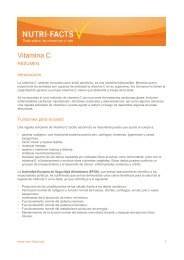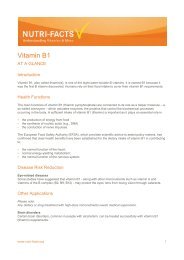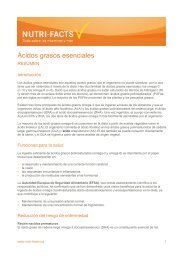Vitamin E - Nutri-Facts.org
Vitamin E - Nutri-Facts.org
Vitamin E - Nutri-Facts.org
Create successful ePaper yourself
Turn your PDF publications into a flip-book with our unique Google optimized e-Paper software.
<strong>Vitamin</strong> E<br />
AT A GLANCE<br />
Introduction<br />
The term vitamin E describes a family of eight related, fat-soluble molecules. Among these, ‘alphatocopherol’<br />
has the highest biological activity and is the most abundant in the human body (1). The name<br />
tocopherol derives from the Greek words tocos, meaning childbirth, and pherein, meaning to bring forth. The<br />
name was coined to highlight its essential role in the reproduction of various animal species.<br />
Health Functions<br />
A sufficient intake of vitamin E (alpha-tocopherol) is important as it<br />
• functions as an antioxidant, protecting cells, tissues, and <strong>org</strong>ans from damaging effects caused by ‘free<br />
radicals’, which are responsible for the aging process and can lead to various health conditions such as<br />
heart disease, cancer, and inflammatory conditions<br />
• inhibits damaging blood clotting, potentially blocking blood flow<br />
• regulates the opening of blood vessels, important for unhindered blood flow.<br />
Disease Risk Reduction<br />
Heart disease<br />
<strong>Vitamin</strong> E helps to prevent arteries from clogging by blocking the conversion of cholesterol into the waxy fat<br />
deposits called ‘plaque’ that stick to blood vessel walls. <strong>Vitamin</strong> E also thins the blood, allowing it to flow<br />
more easily through arteries even when plaque is present.<br />
Numerous clinical studies have reported that the amount of vitamin E ingested in food and in supplements is<br />
associated with a lower risk of heart disease, atherosclerosis and other types of cardiovascular disease.<br />
One large clinical study in postmenopausal women showed that vitamin E supplementation had no effect on<br />
the incidence of stroke but reduced the risk of blockage of blood flow in veins by a blood clot.<br />
Several clinical trials in individuals who were at high risk for cardiovascular events (e.g., stroke) because<br />
they had cardiovascular disease or diabetes failed to demonstrate that vitamin E provides protection.<br />
However, there is evidence that vitamin E may reduce the risk of cardiovascular problems in diabetics with a<br />
particular type of gene found in 36% of the general population.<br />
Eye health<br />
Because of its antioxidant action, vitamin E may help protect against clouding of the lens of the eye<br />
(cataracts) and a progressive deterioration in the retina, the back part of the eye (age-related macular<br />
degeneration, AMD). Both of these eye disorders tend to occur as people age, leading to impaired vision.<br />
www.nutri-facts.<strong>org</strong> 1
To minimize risk of these eye disorders, experts advocate diets high in vitamin E and vitamin C, and<br />
carotenoids.<br />
Immune function<br />
<strong>Vitamin</strong> E has been shown to enhance specific aspects of the immune response that appear to decline as<br />
people age. A clinical trial in elderly nursing home residents reported that daily supplementation with vitamin<br />
E lowered the risk of upper respiratory tract infections, especially the common cold, but had no effect on<br />
lower respiratory tract (lung) infections.<br />
More research is needed to determine whether supplemental vitamin E may protect the elderly against the<br />
common cold or other infections (e.g., flu).<br />
Cancer<br />
Clinical studies have shown that people with cancer often have lower levels of vitamin E in the blood. In<br />
addition, population trials suggest that diets rich in antioxidants, including vitamin E, may be connected to a<br />
reduced risk of certain types of cancer.<br />
Experiments have shown that vitamin E inhibits the growth of some cancers in test tubes and animals,<br />
particularly hormone responsive cancers such as breast and prostate cancer. While these results are<br />
encouraging, the confirmation of these findings by large-scale human studies is still pending.<br />
More research is needed before researchers can come to any firm conclusions about whether added vitamin<br />
E, alone or together with other antioxidant micronutrients, has an impact on cancer in humans and, if so,<br />
what the optimal dosage is.<br />
Alzheimer’s disease<br />
Since researchers believe oxidative stress contributes to the development of Alzheimer’s disease,<br />
antioxidants like vitamin E could potentially help prevent this condition. The fat-soluble vitamin can readily<br />
enter the brain and exert its antioxidative properties.<br />
Clinical studies have suggested that vitamin E supplementation, together with vitamin C, may prevent the<br />
development of Alzheimer’s disease.<br />
Other Applications<br />
Please note:<br />
Any dietary or drug treatment with high-dosed micronutrients needs medical supervision.<br />
Heart disease<br />
Results of clinical trials using vitamin E to treat heart disease have been inconsistent. More evidence is<br />
needed to determine if there are benefits of vitamin E supplementation.<br />
Diabetes<br />
People with diabetes are at increased risk for conditions such as cardiovascular disease. A potential factor<br />
involved in these complications may be low levels of antioxidants, which is frequently observed in these<br />
patients. <strong>Vitamin</strong> E supplements and other antioxidants may help reduce the risk of heart disease and other<br />
complications in people with diabetes.<br />
There is evidence that vitamin E may reduce the risk of cardiovascular problems in type 2 diabetics with a<br />
particular type of gene found in 36% of the general population.<br />
Research indicates that antioxidants might help control blood sugar levels and lower cholesterol levels in<br />
those with type 2 diabetes while protecting against the complications of eye damage (‘retinopathy’) and<br />
kidney damage (‘nephropathy’) in those with type 1 diabetes.<br />
www.nutri-facts.<strong>org</strong> 2
Alzheimer’s disease<br />
There is some evidence that vitamin E might help to treat forms of dementia, such as Alzheimer’s disease.<br />
Since researchers believe oxidative stress contributes to the development of Alzheimer’s disease,<br />
antioxidants like vitamin E could theoretically reduce the risk or progression of the disease.<br />
Clinical studies have suggested that vitamin E supplementation improves cognitive performance in healthy<br />
individuals and in those with dementia from causes other than Alzheimer’s (e.g., multiple strokes).<br />
Eye health<br />
Uveitis is inflammation of the uvea, the middle layer of the eye between the white outer coat of the eye and<br />
the retina. The uvea contains many of the blood vessels that nourish the eye, so inflammation in this area<br />
can affect several important parts of the eye.<br />
Uveitis is another eye disorder for which the antioxidant vitamins E and vitamin C may be helpful. A clinical<br />
study in patients with uveitis found that those who took the vitamins E and C had better visual clarity than<br />
those who took a dummy pill (‘placebo’).<br />
Other disorders<br />
<strong>Vitamin</strong> E, along with other standard treatments, may also be beneficial for treating photodermatitis and<br />
inflammatory diseases (ulcerative colitis, pancreatitis, and osteoarthritis), slowing progression of Parkinson’s<br />
disease, and avoiding miscarriage.<br />
Controlled trials are needed to clarify potential benefits of vitamin E in treating these disorders.<br />
Intake Recommendations<br />
The intake recommendations for vitamin E vary according to age, sex and criteria applied in individual<br />
countries. While in Europe recommendations for adults range from 4 to 15 mg alpha-tocopherol equivalents<br />
per day for men and from 3 to 12 mg per day for women, in the U.S., the recommended intake for adults has<br />
been set at 15 mg natural alpha-tocopherol per day.<br />
The recommended vitamin E intake of 15 mg is not easily achieved even with the best nutritional intentions.<br />
This is problematic as most research studies show that intake levels are often associated with health<br />
benefits.<br />
Supply Situation<br />
In several European countries, a large portion of the population has a mean dietary vitamin E intake below<br />
the recommended level. Surveys estimated that more than 90% of Americans do not meet daily dietary<br />
recommendations for vitamin E.<br />
Deficiency<br />
<strong>Vitamin</strong> E is stored in various tissues. Because depletion of the vitamin E stores takes a very long time, no<br />
overt clinical deficiency symptoms have been noted in otherwise healthy adults.<br />
Symptoms of vitamin E deficiency are seen in patients with fat absorption disorders or liver disease, and in<br />
newborn infants, particularly premature infants.<br />
Symptoms of vitamin E deficiency include muscle weakness, loss of muscle mass, abnormal eye<br />
movements, impaired vision, and unsteady gait.<br />
www.nutri-facts.<strong>org</strong> 3
Chronic deficiency may also cause problems with kidney and liver function. In addition, severe vitamin E<br />
deficiency can be associated with serial miscarriages and premature delivery in pregnant women.<br />
Sources<br />
Vegetable oils (olive, soya beans, palm, corn, safflower, sunflower, etc.), nuts, whole grains and wheat germ<br />
are the most important sources of vitamin E. Other sources are seeds and green leafy vegetables. The<br />
vitamin E content of vegetables, fruits, dairy products, fish and meat is relatively low.<br />
The vitamin E content in foods is often reported as ‘alpha-tocopherol equivalents’ (alpha-TE). This term was<br />
established to account for the differences in biological activity of the various forms of vitamin E (1 mg of<br />
alpha-tocopherol is equivalent to 1 TE).<br />
Safety<br />
<strong>Vitamin</strong> E is considered safe for chronic use even at doses of up to 1,000 mg per day.<br />
Long-term high-dose alpha-tocopherol supplementation may increase the likelihood of bleeding in some<br />
individuals. Some physicians recommend discontinuing high-dose vitamin E supplementation one month<br />
before elective surgery to decrease the risk of bleeding.<br />
Studies have suggested that taking vitamin E supplements long-term may be associated with an increased<br />
risk of death (‘mortality’). However, experts criticized that these studies were conducted on patients at high<br />
risk of a chronic potentially fatal disease, and that to generalize these findings to healthy individuals is very<br />
speculative. In addition, the effects were only observed at a very high dose of 2,000 IU/day, which is many<br />
times the recommended amount.<br />
Moreover, many human long-term studies with much higher doses of vitamin E did not report any adverse<br />
effects.<br />
Tolerable upper intake level<br />
While in the European Union an upper intake level of 300 mg alpha-tocopherol equivalents per day has been<br />
established for adults, in the U.K. this level has been set at 540 mg/day for supplemetal vitamin E, and in the<br />
U.S. at 1,000 mg/day of any form of supplemental alpha-tocopherol.<br />
Drug interactions<br />
Please note:<br />
Because of the potential for interactions, dietary supplements should not be taken with medication without<br />
first talking to an experienced healthcare provider.<br />
www.nutri-facts.<strong>org</strong> 4


